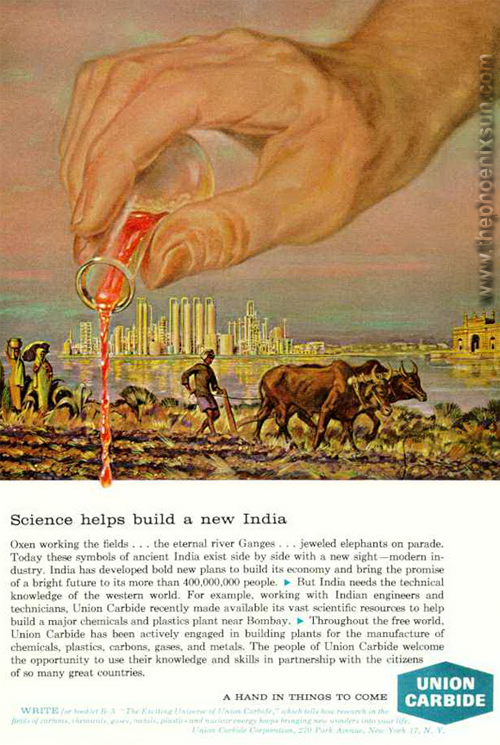The Bhopal Disaster & Climate Change
The sirens started at the Union Carbide plant at 12:50 AM on December 3, 1984. A few people in the surrounding slums may have been awaken by the sound, but even they would have gone back to sleep when the public alarm was turned off after a minute. A second alarm, heard only inside the plant, continued to warn Union Carbide workers.
The two alarms had originally been on a single switch, making it impossible to turn off one without deactivating the other. But frequent leaks caused the alarms to sound so often that the company became concerned about its reputation. They took decisive action in 1982: they decoupled the alarms. That way, the public one could be shut off, while leaving the plant siren on.
Within two hours, 40 tons of methyl isocyanate (MIC) would escape from a large holding tank. The gas, used to make herbicides and pesticides, is heavier than air and so it flowed to the ground until, lifted by the wind, it spread across the crowded slums nearby.
With the public siren turned off, residents first knew something was wrong when they began choking and their eyes burned. (Those closest to the plant didn’t have time to experience any symptoms — they died in their sleep.) Thinking that the problem came from within their own homes, people raced into the streets, where they were immediately enveloped by the cloud of gas. Many were blinded in seconds. Dozens of people fell dead, with babies and children dying first. Pregnant women spontaneously miscarried — and then they themselves died.
Outrunning the cloud was impossible. The gas blanketed a heavily-populated area over 15-square miles.
Early warnings and denials
At 1:15, some quick-thinking person telephoned the police to say that there was a gas leak in the northern part of Bhopal. The police called Union Carbide, but were told that their plant was secure. Officials searched frantically for the source of the leak for the next hour, calling the Union Carbide plant several times to make sure it wasn’t them. Each time, UC insisted there was no problem at their plant.
At 2:00 AM the tank stopped leaking. Almost 15,000 gallons of gas had escaped. Fifteen minutes later, UC restarted the public warning siren. An engineer from UC contacted the police. The leak that — up until that moment — the company had denied any knowledge of, was, he reported “plugged.”
At 2:30, two hours after the leak began, and a half-hour after it had ended, the order was given to evacuate Bhopal.
Within a week, at least 5,000 people had died. (Estimates of the immediate death toll vary from 2,000 to 10,000. An accurate count is impossible). Even today — twenty five year later — residents of Bhopal who were exposed to the deadly cloud continue to die prematurely from cancers and other diseases caused by inhaling MIC and other compounds that leaked that night.

From Bhopal to Copenhagen
I tried, unsuccessfully, to find out if anyone from Bhopal was scheduled to speak at the Climate Summit in Copenhagen.
It seems unlikely. The cheapest airfare I found was $2,300 and the journey takes nearly 24-hours. Bhopal is not a wealthy city like Mumbai or Delhi or Hyderabad. In fact, Bhopal has the highest urban poverty rate in India.
But there is a lesson to learn from the disaster at Bhopal, one that is relevant to the proceedings on climate change about to start in Copenhagen.
 The UC advertisement shown above shares a common theme with the ads run by the coal industry today. Even the language isn’t so different.
The UC advertisement shown above shares a common theme with the ads run by the coal industry today. Even the language isn’t so different.
In the UC ad from the 1960s (in support of the then-new Bhopal plant), a giant, god-like Caucasian hand from the sky pours some kind of elixir from a lab flask onto a “symbol of ancient India”…”oxen working the field” with a dark-skinned Indian behind the wooden plow. In the background just across a river, the UC Bhopal plant rises gleaming and white.
Below the picture a headline provides the take-home message: “Science helps build a new India.”
If Science is a god, as the picture implies, its manifestation here on Earth is Union Carbide.
“Working with Indian engineers and technicians,” states the ad, “Union Carbide recently made available its vast scientific resources to help build a major chemicals and plastic plant near Bombay.”
If there’s still any doubt about UC being Science incarnate, the tag line at the bottom of the page should clear things up. Placed next to the Union Carbide logo, it reads: “A HAND IN THINGS TO COME.”
(That phrase would take on an ironic and foreboding tone, after the Bhopal disaster.)
The billboard above for “clean coal” has been updated for the new millennium, but most of the same elements are present.
In place of a hand, the coal industry ad features a giant light bulb with a beautiful nimbus of other-worldly (and environmentally friendly) green light. The word “COAL” is also green-tinged on the sign. And at the bottom, the advertisement combines the themes of Science and modernity with the words: “CLEAN & GREEN WITH NEW TECHNOLOGIES.”
The Coal Industry: Clean and Green or just plain Mean?
Coal, of course, is neither clean nor green. Burning coal to generate electricity is the single largest source of CO2 emissions, which, in turn, is the primary greenhouse gas driving climate change.
But, the ad seems to promise, coal is no longer a cause of climate change, thanks to NEW TECHNOLOGIES. In fact, these technologies do not yet exist. They may never work at a scale that makes coal a “clean and green” fuel.
And if the most frequently mentioned technology, carbon capture and sequestration (CCS), is somehow made practical, it may create hundreds or thousands of potential Bhopals. The idea behind CCS is to capture millions of tons of CO2 from burning coal and pumping them deep into the earth where, in theory, they won’t leak out.
The same companies that until recently insisted that human-caused climate change is a hoax, now ask us to trust them with a technology they say exists, but doesn’t. (Some of the individuals connected with these companies still insist that there’s no such thing as global warming cause by humans.)
Post-Bhopal, Pre-Copenhagen
Climate change itself is an industrial disaster. It’s just happening over a longer period of time than Bhopal. The economic might and political influence of Union Carbide caused the thousands of deaths in India. In the wake of Bhopal, people in the United States began to wonder what was being made in the chemical plants near them. Should they be concerned? Could “a Bhopal” happen there?
The chemical industry reacted swiftly.
Less than a year after Bhopal, a report to the Chemical Manufacture’s Association Board boasted:
When Bhopal hit in December, the CMA State Affairs organization as a whole was well prepared for the unprecedented flood of state bills that were promptly dumped into the legislative hopper. When the dust settled this year over 150 bills on this subject had been introduced in 40 states, and over 22 states passed some right-to-know provisions. State legislators had developed new proposals to force governmental control on our plants, and tried to move the issue far beyond the CMA position.
Although battles are still being fought in California, New Jersey and Michigan, to date all the laws passed this year are generally consistent with CMA policy. We have retained our trade secret protection rights and successfully avoided costly requirements for unique labeling, environmental emission monitoring and independent risk management audits. [Emphasis added]
Public compensation was another priority issue where the results were good. It was an active issue in five states — California, Massachusetts, New Jersey, Minnesota and Rhode Island. CMA’s position was that NO administrative public compensation program was needed and tort law should not be changed. The CMA Policy Committee’s marching orders to the state troops in the field were clear — “Hold Pork Chop Hill.”
And for the most part, they did: “We were successful in four of the five states…”
The same report cites more good news for the industry:
CMA also played a role in preventing further proliferation of unique state regulations of toxic air contaminants. As an example, Massachusetts has been slowed down in their effort to regulate 450 compounds in six months by shortcutting good science. Reason has prevailed despite Massachusetts’ impatience with the federal government for only promulgating regulations for six (6) hazardous pollutants since 1970.
Business as usual? Or change we can live with?
Avoiding regulation, blocking public access to information, denying culpability for disasters they’ve caused (Union Carbide blamed a disgruntled employee for the leak), sowing doubt where scientific consensus exists — these are the strategies used by industries from tobacco to chemical manufacturing to energy production.
Some of the same entities will be at Copenhagen arguing their case for minimal action and delay. Why would they think that would work? Probably because it usually has. It will require the collective action of people, from all walks of life, and from around the world, to put an end to business as usual.

Filed under: CO2, Intl., Laws, Media
Trackback Uri







